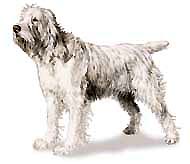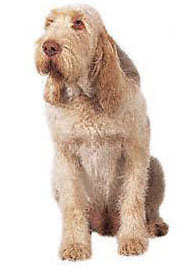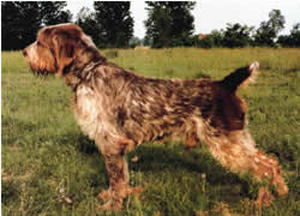Spinone Italiano Breed Standard
General Appearance
Muscular dog with powerful bone. Vigorous and robust, his purpose as hardworking gun dog is evident. Naturally sociable, the docile and patient Spinone is resistant to fatigue and is an experienced hunter on any terrain. His hard textured coat is weather resistant. His wiry, dense coat and thick skin enable the Spinone to negotiate underbrush and endure cold water that would severely punish any dog not so naturally armored. He has a remarkable tendency for an extended and fast trotting gait. The Spinone is an excellent retriever by nature.
Size, Proportion, Substance:
Height: The height at the withers is 23 to 27 inches for males and 22 to 25 inches for females. Weight: In direct proportion to size and structure of dog. Proportion: His build tends to fit into a square. The length of the body, measured from sternum to point of buttocks, is approximately equal to the height at the withers with tolerance of no more than 1 inch in length compared to height. Substance: The Spinone is a solidly built dog, robust with powerful bone.
Head:
Long. The profile of the Spinone is unique to this breed. Expression is of paramount importance to the breed. It should denote intelligence and gentleness. Skull of oval shape, with sides gently sloping. With occipital  protuberance well developed, medial-frontal furrow is very pronounced. Muzzle: Square when viewed from the front. Muzzle length is equal to that of backskull. The planes of the skull and muzzle are diverging, down faced. Its width measured at its midpoint is a third of its length. Stop is barely perceptible. Bridge of the muzzle is preferably slightly Roman, however, straight is not to be faulted. Lips fitting tightly to the jaw line. Convergence of planes of the skull and muzzle or a dish-faced muzzle is to be faulted so severely as to eliminate from further competition. Eyes: Must have a soft sweet expression. Ochre (yellowish brown) in color, darker eyes with darker colored dogs, lighter eyes with lighter colored dogs. Large, well opened, set well apart, the eye is almost round, the lids closely fitting the eye, to protect the eye from gathering debris while the dog is hunting, loose eye lids must be faulted. Which is neither protruding nor deep set. Eye rim clearly visible, color will vary with coat color from flesh colored to brown. Disqualification: Walleye. Nose: Bulbous and spongy in appearance with upper edge rounded. Nostrils are large and well opened. In profile, the nose protrudes past the forward line of the lips. (Pigment is flesh colored in white dogs, darker in white and orange dogs, brown in brown or brown roan dogs.) Disqualification: Any pigment other than described or incomplete pigment of the nose is to be disqualified. Teeth: Jaw is powerful. Teeth are positioned in a scissors or level bite. Disqualification: Overshot or undershot bite. Ears: Practically triangular shape. Set on a level just below the eye, carried low, with little erectile power. The leather is fine, covered with short, thick hair mixed with a longer sparser hair, which becomes thicker along edges. Length, if measured along the head would extend to tip of nose and no more than 1 inch beyond the tip. The forward edge is adherent to the cheek, not folded, but turned outward; the tip of the ear is slightly rounded. protuberance well developed, medial-frontal furrow is very pronounced. Muzzle: Square when viewed from the front. Muzzle length is equal to that of backskull. The planes of the skull and muzzle are diverging, down faced. Its width measured at its midpoint is a third of its length. Stop is barely perceptible. Bridge of the muzzle is preferably slightly Roman, however, straight is not to be faulted. Lips fitting tightly to the jaw line. Convergence of planes of the skull and muzzle or a dish-faced muzzle is to be faulted so severely as to eliminate from further competition. Eyes: Must have a soft sweet expression. Ochre (yellowish brown) in color, darker eyes with darker colored dogs, lighter eyes with lighter colored dogs. Large, well opened, set well apart, the eye is almost round, the lids closely fitting the eye, to protect the eye from gathering debris while the dog is hunting, loose eye lids must be faulted. Which is neither protruding nor deep set. Eye rim clearly visible, color will vary with coat color from flesh colored to brown. Disqualification: Walleye. Nose: Bulbous and spongy in appearance with upper edge rounded. Nostrils are large and well opened. In profile, the nose protrudes past the forward line of the lips. (Pigment is flesh colored in white dogs, darker in white and orange dogs, brown in brown or brown roan dogs.) Disqualification: Any pigment other than described or incomplete pigment of the nose is to be disqualified. Teeth: Jaw is powerful. Teeth are positioned in a scissors or level bite. Disqualification: Overshot or undershot bite. Ears: Practically triangular shape. Set on a level just below the eye, carried low, with little erectile power. The leather is fine, covered with short, thick hair mixed with a longer sparser hair, which becomes thicker along edges. Length, if measured along the head would extend to tip of nose and no more than 1 inch beyond the tip. The forward edge is adherent to the cheek, not folded, but turned outward; the tip of the ear is slightly rounded.
Neck, Topline, Body:
Neck: Strong, thick, and muscular. Clearly defined from the nape, blending in to the shoulders in a harmonious line. The throat is moderate in skin with a double dewlap. Chest: Broad, deep, well muscled and well rounded; extending at least to the elbow. The ribs are well sprung. The distance from ground to the elbow is equal to 1/2 the height at the withers. Back: The topline consists of two segments. The first slopes slightly downward in a nearly straight line from the withers to the 11th thoracic vertebrae, approximately 6 inches behind the withers. The second rises gradually and continues into a solid and well-arched loin. The underline is solid and should have minimal tuck up. Croup: Well muscled, long. The hipbones fall away from the spinal column at an angle of about 30 degrees, producing a lightly rounded, well filled-out croup. Tail: Follows the line of the croup, thick at the base, carried horizontally or down; flicking from side to side while moving is preferred. The tail should lack fringes. It is docked to a length of 5 1/2 to 8 inches. Tail habitually carried above the level of the back or straight up when working is to be penalized.
Forequarters:
Shoulders: Powerful and long, withers not too prominent; forming an angle with the upper arm of approximately angle 105. With well-developed muscles, the points of the shoulder blades are not close together. The ideal distance between the shoulder blades is approximately two inches or more. Angulation of shoulder is in balance with angulation in the rear. Forelegs: The forelegs are straight when viewed from the front angle with strong bone and well-developed muscles; elbows set under the withers and close to the body. Pasterns are long, lean and flexible following the vertical line of the forearm. In profile, they are slightly slanted. Feet: Large compact, rounded  with well-arched toes, which are close together, covered with short, dense hair, including between the toes. Pads are lean and hard with strong nails curving toward the ground, well pigmented, but never black. Dewclaws may be removed. with well-arched toes, which are close together, covered with short, dense hair, including between the toes. Pads are lean and hard with strong nails curving toward the ground, well pigmented, but never black. Dewclaws may be removed.
Hindquarters:
Thighs are strong and well muscled, stifles show good function angulation, lower thigh to be well developed and muscled with good breadth. The hock, with proportion of 1/3 the distance from the hip joint to foot being ideal, is strong, lean and perpendicular to the ground. Fault: Cowhocks. Feet: Slightly more oval than the forefoot with the same characteristics. Dewclaws may be removed.
Skin:
The skin must be very thick, closely fitting the body. The skin is thinner on the head, throat, groin, under the legs and in the folds of the elbows is soft to the touch. Pigmentation is dependent upon the color or markings of the coat. Disqualification: Any black pigmentation.
Coat:
A Spinone must have a correct coat to be of correct type. The ideal coat length is 1 1/2 to 2 1/2 inches on the body, with a tolerance of 1/2 inch over or under the ideal length. Head, ears, muzzle and front sides of legs and feet are covered by shorter hair. The hair on the backsides of the legs forms a rough brush, but there are never any fringes. The eyes and lips are framed by stiff hair forming eyebrows, mustache and tufted beard, which combine to save fore face from laceration by briar and bush. The coat is dense, stiff and flat or slightly crimped, but not curly, with an absence of undercoat. The Spinone is exhibited in a natural state. The appearance of the Spinone may not be altered. The dog must present the natural appearance of a functional field dog. Dogs with a long, soft or silky coat,  the presence of undercoat, or any deviation of the coat is defined in this as well as excessive grooming, i.e., scissoring, clipping, or setting of pattern shall be severely penalized as to eliminate them from further competition. the presence of undercoat, or any deviation of the coat is defined in this as well as excessive grooming, i.e., scissoring, clipping, or setting of pattern shall be severely penalized as to eliminate them from further competition.
Color:
The accepted colors are: Solid white, white and orange; orange roan with or without orange markings; white with brown markings, brown roan with or without brown markings. The most desired color of brown is chestnut brown, "monks habit", however, varying colors of brown are acceptable. Disqualification: Any black in the coat, tan, tri-color, in any combination, or any color other than accepted colors.
Gait: The Spinone is first and foremost a functional working gun dog. Its purpose as a versatile hunting dog must be given the utmost consideration. Easy and loose trot geared for endurance. Maximum ground is covered with least amount of effort, which his purpose as a versatile working gun dog demands. Profile of the topline kept throughout the trotting gait, light body roll in mature bitches is characteristic of the breed. While hunting, an extended fast trot with intermittent paces of a gallop allows the Spinone to cover ground quickly and thoroughly. Any characteristics that interfere with the accomplishment of the function of the Spinone shall be considered as a serious fault.
Faults: Any departure from the foregoing points constitutes a fault which when judging must be penalized according to its seriousness and extension.
Disqualification
Wall Eye
Any pigment other than described or incomplete pigment of the nose.
Overshot or undershot bite.
Any black pigmentation.
Any black in the coat; tan, tri-color markings in any combination, or any color other than accepted colors.
|


 protuberance well developed, medial-frontal furrow is very pronounced. Muzzle: Square when viewed from the front. Muzzle length is equal to that of backskull. The planes of the skull and muzzle are diverging, down faced. Its width measured at its midpoint is a third of its length. Stop is barely perceptible. Bridge of the muzzle is preferably slightly Roman, however, straight is not to be faulted. Lips fitting tightly to the jaw line. Convergence of planes of the skull and muzzle or a dish-faced muzzle is to be faulted so severely as to eliminate from further competition. Eyes: Must have a soft sweet expression. Ochre (yellowish brown) in color, darker eyes with darker colored dogs, lighter eyes with lighter colored dogs. Large, well opened, set well apart, the eye is almost round, the lids closely fitting the eye, to protect the eye from gathering debris while the dog is hunting, loose eye lids must be faulted. Which is neither protruding nor deep set. Eye rim clearly visible, color will vary with coat color from flesh colored to brown. Disqualification: Walleye. Nose: Bulbous and spongy in appearance with upper edge rounded. Nostrils are large and well opened. In profile, the nose protrudes past the forward line of the lips. (Pigment is flesh colored in white dogs, darker in white and orange dogs, brown in brown or brown roan dogs.) Disqualification: Any pigment other than described or incomplete pigment of the nose is to be disqualified. Teeth: Jaw is powerful. Teeth are positioned in a scissors or level bite. Disqualification: Overshot or undershot bite. Ears: Practically triangular shape. Set on a level just below the eye, carried low, with little erectile power. The leather is fine, covered with short, thick hair mixed with a longer sparser hair, which becomes thicker along edges. Length, if measured along the head would extend to tip of nose and no more than 1 inch beyond the tip. The forward edge is adherent to the cheek, not folded, but turned outward; the tip of the ear is slightly rounded.
protuberance well developed, medial-frontal furrow is very pronounced. Muzzle: Square when viewed from the front. Muzzle length is equal to that of backskull. The planes of the skull and muzzle are diverging, down faced. Its width measured at its midpoint is a third of its length. Stop is barely perceptible. Bridge of the muzzle is preferably slightly Roman, however, straight is not to be faulted. Lips fitting tightly to the jaw line. Convergence of planes of the skull and muzzle or a dish-faced muzzle is to be faulted so severely as to eliminate from further competition. Eyes: Must have a soft sweet expression. Ochre (yellowish brown) in color, darker eyes with darker colored dogs, lighter eyes with lighter colored dogs. Large, well opened, set well apart, the eye is almost round, the lids closely fitting the eye, to protect the eye from gathering debris while the dog is hunting, loose eye lids must be faulted. Which is neither protruding nor deep set. Eye rim clearly visible, color will vary with coat color from flesh colored to brown. Disqualification: Walleye. Nose: Bulbous and spongy in appearance with upper edge rounded. Nostrils are large and well opened. In profile, the nose protrudes past the forward line of the lips. (Pigment is flesh colored in white dogs, darker in white and orange dogs, brown in brown or brown roan dogs.) Disqualification: Any pigment other than described or incomplete pigment of the nose is to be disqualified. Teeth: Jaw is powerful. Teeth are positioned in a scissors or level bite. Disqualification: Overshot or undershot bite. Ears: Practically triangular shape. Set on a level just below the eye, carried low, with little erectile power. The leather is fine, covered with short, thick hair mixed with a longer sparser hair, which becomes thicker along edges. Length, if measured along the head would extend to tip of nose and no more than 1 inch beyond the tip. The forward edge is adherent to the cheek, not folded, but turned outward; the tip of the ear is slightly rounded.  with well-arched toes, which are close together, covered with short, dense hair, including between the toes. Pads are lean and hard with strong nails curving toward the ground, well pigmented, but never black. Dewclaws may be removed.
with well-arched toes, which are close together, covered with short, dense hair, including between the toes. Pads are lean and hard with strong nails curving toward the ground, well pigmented, but never black. Dewclaws may be removed.  the presence of undercoat, or any deviation of the coat is defined in this as well as excessive grooming, i.e., scissoring, clipping, or setting of pattern shall be severely penalized as to eliminate them from further competition.
the presence of undercoat, or any deviation of the coat is defined in this as well as excessive grooming, i.e., scissoring, clipping, or setting of pattern shall be severely penalized as to eliminate them from further competition.